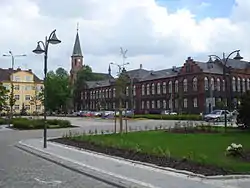Nový Bohumín
Nový Bohumín, lit. "New Bohumín" (Polish: Nowy Bogumin) is a part of the town of Bohumín in Karviná District, Moravian-Silesian Region, Czech Republic. It has a population of 14,033 (August 2009).[1]

History
It is the newest part of today's town of Bohumín. First buildings appeared in the middle of the 19th century, when the Bohumín-Košice railway line was being constructed. Residential houses for workers, as well as industrial buildings were built. At the end of the 19th century and the beginning of the 20th century several important buildings were built in Neo-Gothic architectural style.
After World War I, fall of Austria-Hungary, Polish–Czechoslovak War and the division of Cieszyn Silesia in 1920, it became a part of Czechoslovakia. The settlement, known as Bohumín-nádraží (Bohumín-train station), was renamed to Nový Bohumín in April 1924. On 16 October 1924 the Czechoslovak government gave the settlement the town rights. Following the Munich Agreement, in October 1938 together with the Zaolzie region it was annexed by Poland, administratively organised in Frysztat County of Silesian Voivodeship.[2] The town was then annexed by Nazi Germany at the beginning of World War II. After the war it was restored to Czechoslovakia.
Today it forms the largest, as well as most industrialised part of the town of Bohumín.
The most important landmarks are the Catholic Church of the Divine Heart of the Lord from 1896; town hall from 1897–1898; complex of former German schools from 1894–1914; and the Lutheran church from 1901.
Footnotes
- Population statistics of Bohumín
- "Ustawa z dnia 27 października 1938 r. o podziale administracyjnym i tymczasowej organizacji administracji na obszarze Ziem Odzyskanych Śląska Cieszyńskiego". Dziennik Ustaw Śląskich (in Polish). Katowice. nr 18/1938, poz. 35. 31 October 1938. Retrieved 1 July 2014.